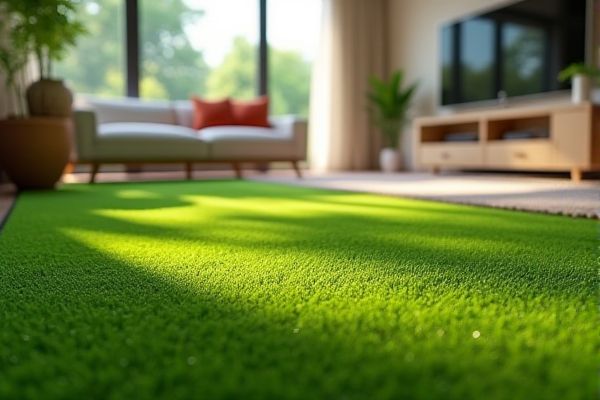
Artificial turf offers durability and low maintenance, making it ideal for high-traffic areas, while natural grass provides a cooler surface and a more authentic aesthetic. Discover how each option impacts your environment, cost, and usability by reading the rest of the article.
Table of Comparison
| Feature | Artificial Turf | Natural Grass |
|---|---|---|
| Maintenance | Low - requires occasional cleaning and brushing | High - requires mowing, watering, fertilizing, and pest control |
| Durability | High - withstands heavy use and harsh weather | Moderate - prone to wear and weather damage |
| Cost | Higher initial installation, lower long-term upkeep | Lower initial cost, higher ongoing maintenance expenses |
| Playability | Consistent surface, less impacted by weather | Natural cushioning, affected by rain and drought |
| Environmental Impact | Non-biodegradable materials, heat retention issues | Supports biodiversity, improves air quality |
| Lifespan | 8-15 years depending on quality and usage | Continuous renewal, season-dependent growth |
| Injury Risk | Possible surface abrasions and higher heat stress | Natural cushioning reduces impact injuries |
Overview of Artificial Turf and Natural Grass
Artificial turf consists of synthetic fibers designed to mimic the appearance and feel of natural grass, offering durability and low maintenance for sports fields and residential lawns. Natural grass provides environmental benefits such as oxygen production, temperature regulation, and natural aesthetics but requires regular watering, mowing, and fertilizing. Both options present distinct advantages and challenges related to installation costs, upkeep, and environmental impact.
Installation Process Comparison
The installation process of artificial turf involves laying a geotextile fabric, applying a base layer of crushed stone for drainage, then rolling out and securing synthetic fibers, typically completed within a few days. Natural grass installation requires soil preparation, seeding or sod laying, and a lengthy establishment period with irrigation and maintenance to promote root growth. Artificial turf offers a quicker, low-maintenance setup, whereas natural grass demands more time and ongoing care for healthy growth.
Maintenance Requirements
Artificial turf requires minimal maintenance, needing only occasional brushing and rinsing to remove debris and maintain fiber uprightness. Natural grass demands regular mowing, watering, fertilizing, and pest control to stay healthy and visually appealing. The reduced maintenance time and cost make artificial turf a practical choice for high-traffic areas and drought-prone regions.
Environmental Impact
Artificial turf reduces water consumption by eliminating the need for irrigation, making it a sustainable choice in drought-prone areas. However, its production involves non-biodegradable materials and can contribute to microplastic pollution. Natural grass supports biodiversity, improves air quality, and reduces urban heat, benefiting Your local ecosystem despite requiring more maintenance resources.
Cost Analysis: Upfront and Long-Term
Artificial turf demands a higher initial investment ranging from $5 to $20 per square foot, while natural grass installation typically costs $1 to $2 per square foot. Over time, natural grass incurs ongoing expenses such as watering, mowing, fertilizing, and pest control, which can total thousands of dollars annually depending on your lawn size and climate. Artificial turf's low maintenance lowers long-term costs, making it a cost-effective option despite upfront expenses.
Safety and Health Considerations
Artificial turf reduces risks associated with allergies and pesticide exposure common in natural grass but may increase skin abrasion and heat-related injuries due to higher surface temperatures. Natural grass provides a cooler surface and better shock absorption, which can lower the incidence of heat stress and impact injuries. However, it requires maintenance involving fertilizers and pesticides that pose potential health hazards to players and ecosystems.
Aesthetic and Playability Differences
Artificial turf offers consistent color and texture year-round, maintaining a pristine appearance without patches or mud, while natural grass provides a lush, vibrant look that changes with seasons. Playability on artificial turf remains uniform regardless of weather, offering reliable traction and shock absorption, whereas natural grass can impact game dynamics with softer feel but variable firmness and potential for muddy or uneven surfaces. Your choice between the two depends on whether you prioritize a flawless, low-maintenance aesthetic or the traditional, organic experience of natural grass play.
Durability and Lifespan
Artificial turf offers superior durability with a lifespan of 8 to 15 years, resisting heavy foot traffic and extreme weather conditions without significant wear. Natural grass typically lasts indefinitely with proper maintenance but suffers from damage due to overuse, pests, and climate variations, requiring frequent repair and reseeding. Turf requires less downtime for maintenance, making it ideal for high-use sports fields and commercial landscapes.
Climate and Weather Resilience
Artificial turf offers superior climate and weather resilience compared to natural grass, maintaining its appearance and functionality in extreme heat, heavy rain, and drought conditions without requiring extensive maintenance. Natural grass often suffers from browning, muddy patches, and slow recovery after adverse weather, impacting its usability and aesthetic appeal. Your choice of artificial turf ensures consistent performance and durability regardless of seasonal fluctuations or challenging weather patterns.
Choosing the Best Option for Your Needs
Artificial turf offers low maintenance and durability, making it ideal for high-traffic areas or regions with limited water supply. Natural grass provides a cooler surface and natural aesthetics, benefiting outdoor activities and environmental health. Consider your climate, budget, and usage to choose the best option for your needs.
 homyna.com
homyna.com